Spade vs. Shovel: What’s the Difference?
We independently evaluate all recommended products and services. If you click on links we provide, we may receive compensation.
Many gardeners and outdoor enthusiasts often use the terms ‘spade’ and ‘shovel’ interchangeably, leading to some confusion. While they might seem similar at a glance, a closer look at the spade vs. shovel comparison reveals distinct differences that are important to understand for anyone passionate about gardening or landscaping.
This article aims to shed light on the ‘spade and shovel’ dilemma, offering a clear and concise summary of the key differences that set these tools apart. Below, you’ll find an overview of the primary distinctions between a spade and a shovel, presented in a way that’s easy to grasp and remember.
We will then dive deeper into the specifics of each tool, exploring their designs, uses, and how they can each play a vital role in your gardening toolkit. So, whether you’re a seasoned gardener or just starting out, keep reading to get a comprehensive understanding of these essential gardening tools.
At a Glance
| Shovel | Spade | |
|---|---|---|
| Blade Shape | Bowl-shaped (concave) with a rounded or pointed tip | Flat (or nearly flat) with a straight edge |
| Handle/Shaft | Long, straight shaft | Shorter shaft, may have a “T” or “D” handle |
| Blade Size | Larger | Smaller |
| Best Uses | Digging, breaking up, and turning soil | Slicing through soil and roots, moving soil and loose material |
>> Related Article: How to Sharpen a Spade
Everything You Need to Know About Shovels and Spades
Materials, Weight, and Cost
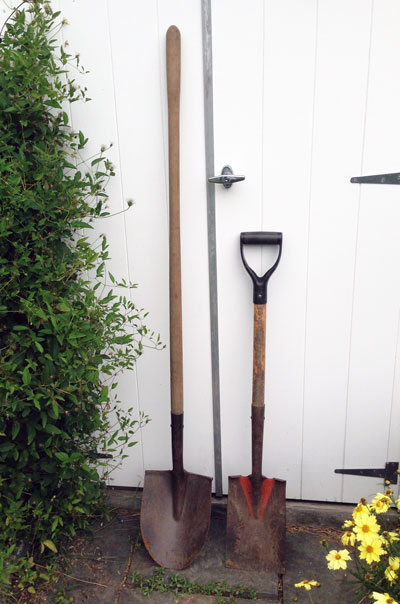
The shovel (left) is longer than the spade (right).
There’s very little difference between shovels and spades in terms of the materials used. Both can be found with wood or fiberglass handles, and with carbon or stainless steel blades.
Weight is mostly dependent on materials used, as is the cost. Weight and cost will also vary with the intended use of the tool; those used for specialty purposes will generally cost more.
The biggest differences between shovels and spades are found in the handle/shaft and the blade.
About the Blade
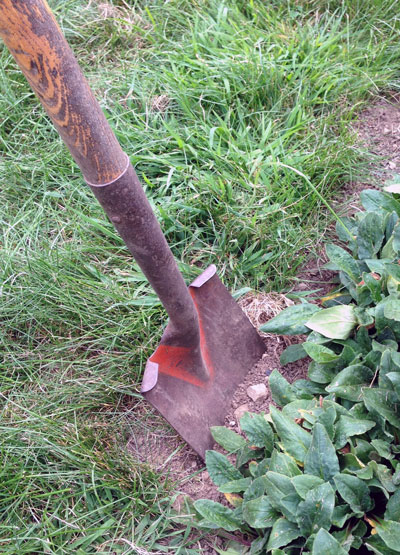
The square spade blade is ideal for edging garden beds
The blade, or scoop, is used to cut through soil, roots, or sod and to move soil, sand, gravel, etc.
The larger the blade, the more material you can move. But be careful that it’s not too large or you may find that you can’t lift a full load or that you tire quickly.
Sharply pointed blades are more effective at cutting into hard ground or through tough materials like roots, while flat blades are best for edging and lifting loose material.
About the Handle / Shaft
A longer handle, or shaft, provides greater leverage and is useful for heavier work and for cutting through roots and tough ground, while a shorter handle provides greater control and is often useful for planting or digging up bulbs.
In Detail….
Shovel vs. Spade Blade
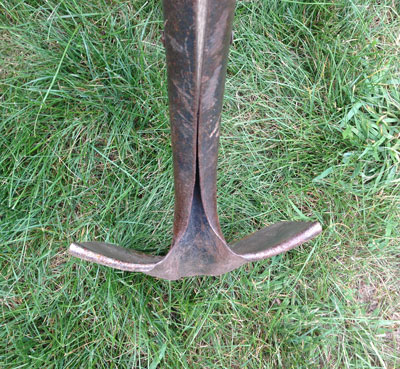
The shovel blade is typically curved
A shovel has a broader blade that is curved inwards from left to right and is rounded or pointed at the tip. Blade length and shape can vary, depending on the intended use – you’ll find shovels with extra long blades, saw-tooth edges, and ledges down the sides. The shovel blade tends to be larger than that found on spades.
A spade generally has a relatively flat blade with straight edges. It’s smaller than a shovel (although size does vary, depending on use) and the blade tends to be in line with the shaft, rather than angled forward.
Shovel vs. Spade Handle/Shaft
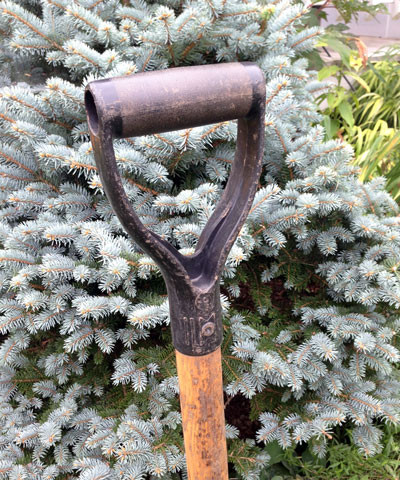
A “D” or “YD” handle on a spade
A shovel typically has a long, straight handle that allows you to get plenty of leverage when digging deep holes.
In contrast, a shorter shaft works best with a spade and comes in handy when working in tight spaces, such as a flowerbed.
Many spades have a “T” or “DY” handle to give you more options for holding it.
Shovel vs. Spade Shape
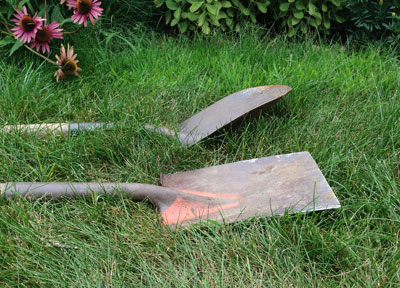
The spade (foreground) is generally straighter than the shovel (background)
You may also notice that a spade tends to be straighter than a shovel from handle to blade tip. Whereas the shovel blade is usually angled forward, the spade blade is not.
It’s that angle that makes the biggest difference in functionality between the two tools. The angled shovel blade makes it efficient for digging.
The straighter spade can be used for digging but is better used for slicing through and lifting sod, edging lawns and beds, skimming weeds and opening straight-sided holes or trenches.
In Summary…
While you can manage with only a shovel or a spade, your gardening will be more efficient and enjoyable if you have both.
And now over to you – Which do you use, a shovel or a spade? Do you have a favorite? Share your thoughts in the comments below!
We Recommend
We’ve reviewed a lot of shovels and spades here on the Gardening Products Review and have found a few that we highly recommend.

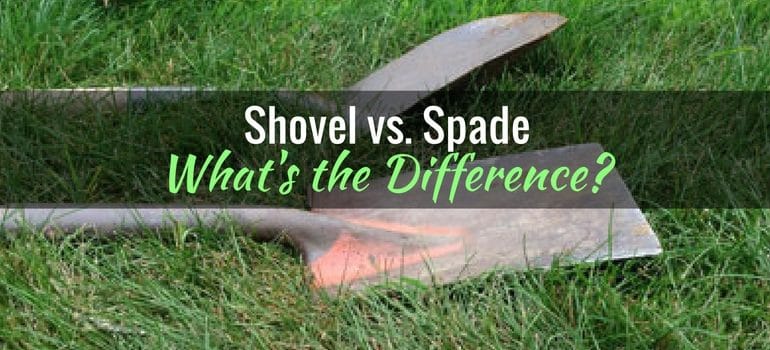

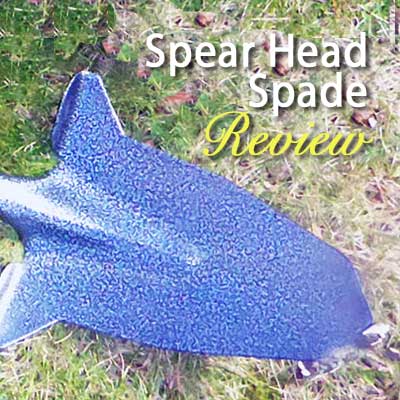
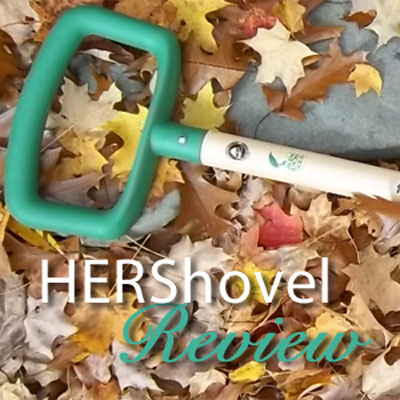
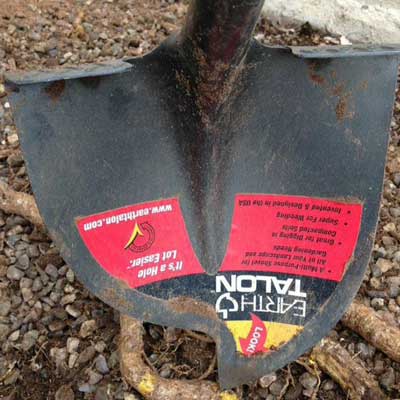




Pingback: Gardening Tools | The Mindful Moment Blog
I always thought a shovel was the one with rectangular shape. It’s called “snow shovel” not “snow spade” right? But a “snow shovel” looks more like the one described as a spade here. I’m not very faimilar with using that shape in the garden. Most garden spades/shovels I have seen have had a shovel blade with a spade handle. |>—D
LOL – it is confusing! And there are so many “hybrid” versions these days, especially among ergonomic options, that it’s hard to keep things straight …
Hi Monica: return we had an argument about this at work the other day. The difference between a spade and a shovel. It turns out I was correct. They kept referring to a spade as that on the cards. Thanks for the clarification- cheers Rick
Glad it was helpful!
HI. i beg to differ. Let us start with the basics:
Shovels are for shoveling.
Spades are for breaking ground.
The implements shown in the article and labeled as ‘shovel’ and ‘spade’ are both hybrids, attempts to combine the functions of both in one tool. The shovel have been give cutting abilitý by giving it a rounded blade (even though that makes it less easy to shovel up the last bits of sand from a pile on flat surface).
and the spade have been given some shoveling ability by straightening the edge to better sweep up those grains of sand, at the cost of the rounded edge that is easier to push through the turf.
I blame the notion of “product development”. Both tools depicted have lost the advantage for their intended purpose, in an attempt to make them usable for both purposes.
Apart from that I quite agree that the shovel handle need to be longer (for the leverage) and the shovel blade should be angled (so you don’t scrape your knuckles trying to sweep up lose dirt) while the spade should be as straight as possible.
love Jakob A
I think I’m with Jakob here.
When I look up the definitions on oxforddictionaries.com and also on merriam-webster.com they both define the shovel as “with a broad blade and typically upturned sides, used for moving coal, earth, snow, or other material.” while the spade is defined as “A tool with a sharp-edged, typically rectangular, metal blade and a long handle, used for digging or cutting earth, sand, turf, etc.”.
I’m also thinking of the terms “snow shovel” and “coal shovel” that are both of the “flat design”.
I would very much like some more insight/clarification on these definitions from Monica 🙂
Or are these differences more US/UK related?
So many options and hybrid versions make things a little confusing … 🙂
A shovel is rounded, has a longer angled handle, and is used for digging/moving stuff. In the garden, that usually means moving gravel, soil, compost, etc. – not usually coal 😉 – digging larger holes or digging up larger plants where you need more leverage to get the rootball out of the ground.
A spade is rectangular, flat, typically has a shorter handle, and is used for edging and cutting, as well as smaller digging/transplanting jobs.
Both can be used for either purpose but are best suited for the purpose for which they were designed. I sure wouldn’t want to move a large pile of compost with a spade!
As for a “snow shovel” – that’s just one more example of the term “shovel” being used loosely to apply to anything used for digging, pushing or scraping material. Here in the USA people very rarely use the word “spade” (other than when playing cards!) – pretty much everything is just called a “shovel”…
Does that clear things up? I think the article above and the dictionary are saying the same thing.
This has surely become a bit messy as they seem to have become almost synonymous.
To me – and to the primary definitions in dictionaries – a shovel is used to move already loose, “fluid” material from one area to another. A spade on the other hand is used to break up closely packed material in order for it to become loose and “fluid”. Therefore some of the attributes you describe for the tools are correct but I would disagree that either tool definitively has either a pointed or flat tip. Nor do they have set handle lengths; a long handled spade is an excellent tool. The key differentiators are the angle between the blade/head and handle, the degree of concavity of the blade/head, the presence of “treads” and the ability to stand on the head: only spades should have them, and maybe the thickness and sharpness of the blade/head. Trying to break heavy ground with a highly angled shovel – without “treads” – is needlessly difficult as is trying to move large amounts of loose material with a much less angled spade.
Anyone can of course dig with a shovel and shovel with a spade. Toolmakers can also call a spade a shovel and a shovel a spade or make any weird hybrid they like. They’re also free to make and sell tools without any consideration given to their performance. To me a well designed spade or shovel should be obviously inadequate for the other’s task.
I’m here because I asked my son for a spade and we disagreed on the definition. I was led to believe a spade blade looks like the spade on a playing card, however after reading posts above I agree only with JAKOB, CARL, and ME, especially after reading the Etymology of shovel. It’s the hybrid of the two that is causing confusion. In their purest forms, a shovel is used to move ‘stuff’ from one place to another and is designed to do so (wide blade, raised sides to hold material), while a spade is used to dig into ‘stuff’ easily with the use of a foot on the upper edge so our weight can help slice into the material. Whether the blade’s bottom is flat or rounded is simply a design consideration for its primary intended use (hole digging vs garden edging). Parting words: All spades are a form of shovel, not all shovels are spades.
Thank you, this statement made he most sense to me.
My garden shovel has a short “YD” handle and a flat surface on top of the blade. It’s great for digging in the clay soil around here.
Oh, shoot! All these years playing cards and I should have been hiding an “Ace of Shovels” up my sleeve.
Unfortunately, no one addressed the question about which I am curious; What is a spade shovel? This is a product that is advertised at Walmart and other places and it seems to be a ‘narrow’ spade, but what makes it a “spade-shovel”?